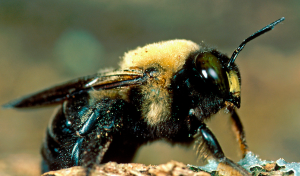Carpenter bee: Difference between revisions
Jump to navigation
Jump to search
No edit summary |
|||
| Line 1: | Line 1: | ||
== Overview == | == Overview == | ||
If you ever wonder if there were bees near wood structures around your home, chances are those are carpenter bees. They are large, solitary bees belonging to the genus Xylocopa. They get their name from the female bee because they bore into wood to create tunnels when they lay their eggs. | If you ever wonder if there were bees near wood structures around your home, chances are those are carpenter bees. They are large, solitary bees belonging to the genus Xylocopa. They get their name from the female bee because they bore into wood to create tunnels when they lay their eggs. | ||
== Indentification == | |||
They can range from 0.7 to 1 inches long. The thorax is covered with fuzzy yellow, orange, or white hairs. The abdomen is shiny black, The female has an entirely black head while the male has yellow or white markings. | |||
They closely resemble bumble bees, unlike carpenter bees, bumble bee's entire body is covered with hairs, they are also social, living together in an underground nest.[2] | |||
{| class="wikitable" style="text-align:center; float:right; margin-right: 10px; | {| class="wikitable" style="text-align:center; float:right; margin-right: 10px; | ||
Revision as of 20:42, 29 April 2025
Overview
If you ever wonder if there were bees near wood structures around your home, chances are those are carpenter bees. They are large, solitary bees belonging to the genus Xylocopa. They get their name from the female bee because they bore into wood to create tunnels when they lay their eggs.
Indentification
They can range from 0.7 to 1 inches long. The thorax is covered with fuzzy yellow, orange, or white hairs. The abdomen is shiny black, The female has an entirely black head while the male has yellow or white markings. They closely resemble bumble bees, unlike carpenter bees, bumble bee's entire body is covered with hairs, they are also social, living together in an underground nest.[2]

| |
| Kingdom: | Animalia |
|---|---|
| Phylum: | Arthropoda |
| Class: | Insecta |
| Order: | Hymenoptera |
| Family: | Apidae |
| Genus: | Xylocopa |